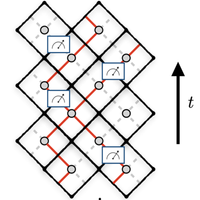Abstract
Monitored quantum circuits can exhibit an entanglement transition as a function of the rate of measurements, stemming from the competition between scrambling unitary dynamics and disentangling projective measurements. We study how entanglement dynamics in nonunitary quantum circuits can be enriched in the presence of charge conservation, using a combination of exact numerics and a mapping onto a statistical mechanics model of constrained hard-core random walkers. We uncover a charge-sharpening transition that separates different scrambling phases with volume-law scaling of entanglement, distinguished by whether measurements can efficiently reveal the total charge of the system. We find that while Rényi entropies grow sub-ballistically as in the absence of measurement, for even an infinitesimal rate of measurements, all average Rényi entropies grow ballistically with time . We study numerically the critical behavior of the charge-sharpening and entanglement transitions in U(1) circuits, and show that they exhibit emergent Lorentz invariance and can also be diagnosed using scalable local ancilla probes. Our statistical mechanical mapping technique readily generalizes to arbitrary Abelian groups, and offers a general framework for studying dissipatively stabilized symmetry-breaking and topological orders.
10 More- Received 14 September 2021
- Accepted 12 August 2022
DOI:https://doi.org/10.1103/PhysRevX.12.041002
Published by the American Physical Society under the terms of the Creative Commons Attribution 4.0 International license. Further distribution of this work must maintain attribution to the author(s) and the published article’s title, journal citation, and DOI.
Published by the American Physical Society
Physics Subject Headings (PhySH)
Popular Summary
The “scrambling” of quantum information has emerged as a fundamental ingredient in the understanding of quantum thermalization, chaos, and spreading of errors in quantum computations. The robustness of this scrambling to external interference has been studied by subjecting the system to random measurements. These studies have led to new insights into the role of unitary evolution as an efficient quantum encoder that protects information from outside interference. Most studies until now have been restricted to systems having no symmetry. However, physical systems often obey symmetries that give rise to conservation laws, such as conservation of total electrical charge. Here, we provide the first step to bridge this gap by theoretically investigating a generic quantum system with a conserved charge.
Previous studies on systems with no symmetry have found that a phase transition, characterized by the system’s ability (or inability) to scramble extensive amounts of information, occurs as we increase the rate of the measurements. In our work, we consider a system of quantum spins subject to measurements of the charge taken randomly in space and time with some fixed probability. In addition to the transition mentioned above, we find another transition at a lower rate of measurement wherein the measurements can efficiently identify the global charge of the system. We call this a “charge-sharpening” transition.
Though the focus of our work is on systems with charge conservation arising from a particular symmetry, we argue that our results are much more general. A better understanding of the newly found charge-sharpening transition and extensions to different symmetries represent a clear challenge for future work.



